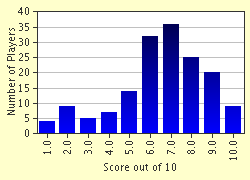Quiz Answer Key and Fun Facts
1. What area of land was being disputed in the French and Indian War?
2. George Washington, the first president of the United States (aka the guy on the dollar bill), fought for the British in the the French and Indian War. What was his rank?
3. General Edward Braddock was sent from Britain to assist the colonists in battle during the the French and Indian War. He was known for being a rather stubborn man. What was his nickname?
4. Braddock and his troops went to capture Fort Duquesne, the French stronghold. The Indians and French were watching from behind, waiting to ambush the British. The Indians came out, attacked, the French began attacking, the British fought back and General Braddock was killed. How?
5. Braddock's defeat at Duquesne meant that they needed new leadership. The British sent James Wolfe to the rescue. What was the name of the leading British Minister for most of the the French and Indian War (though, strictly speaking, he was Prime Minister or First Lord of the Treasury) only from 1756-57)?
6. The Indians were brutal fighters. Their main technique was to cut off the top of their enemy's head. What was this called?
7. Musket balls were the ammunition for the muskets used by both sides during the the French and Indian War. When historians later excavated the graves, they found musket balls. What was unusual about most of them?
8. During the the French and Indian War, the British laid out a plan to get into Quebec. Which of the following things did not precede getting into Quebec?
9. Marquis de Montcalm awoke to see 4,000 British troops as he looked onto the Plains of Abraham. The French, Indians, and British fought, but there were losses on both sides. Marquis de Montcalm and the British General were both killed. Who was the general?
10. When the French and Indian War was over, the French signed the Treaty of Paris and so did the Spanish and the British. What land did Spain lose as a result?
Source: Author
ninny490
This quiz was reviewed by FunTrivia editor
bloomsby before going online.
Any errors found in FunTrivia content are routinely corrected through our feedback system.


